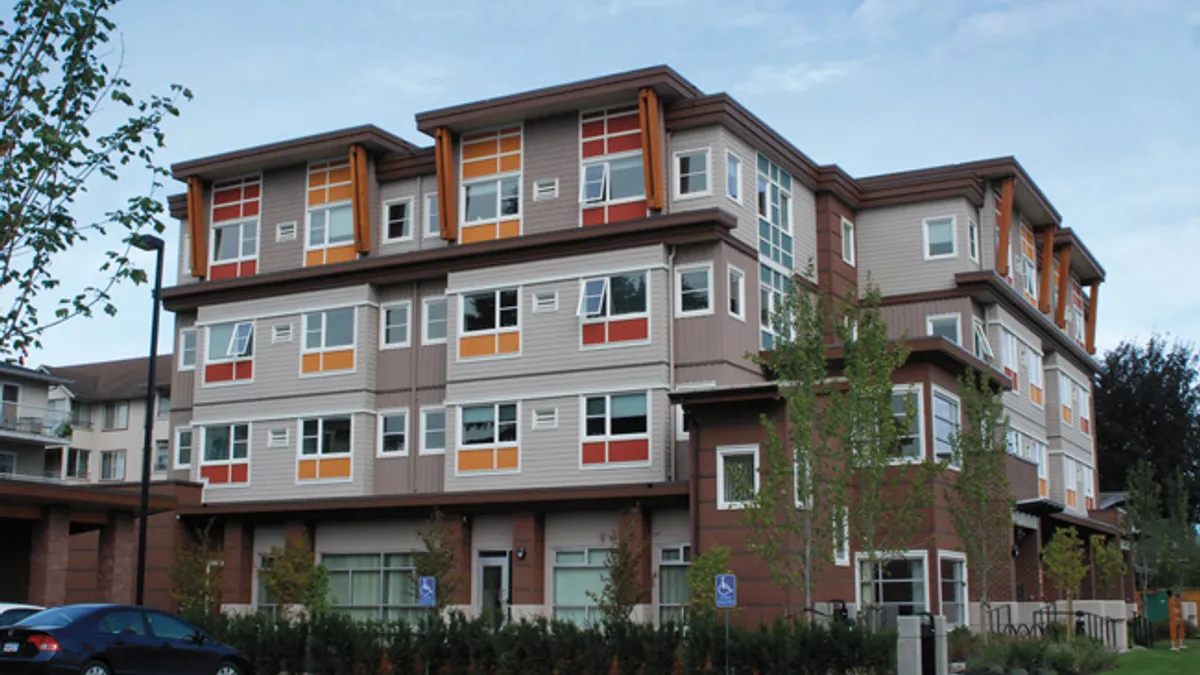Editor's note: This feature is part of a series focused on offsite construction. To view other articles in the series, check out the spotlight page.
Forget about the prefabricated kit homes of the 20th century. Today's offsite construction industry figures into many different types of projects, from whole-building modular solutions to prefabricated mechanical, electrical and plumbing systems that help contractors accelerate schedules and use less labor on site.
Three terms are typically used to describe structural components that are not built on a traditional job site: offsite, prefabricated (prefab) and modular. Although they sound similar — and are — there are a few key differences.
Offsite
Offsite construction refers to any building process that takes place away from the ultimate point of installation, and the term includes both prefabrication and modular construction. One of the primary benefits of being able to build parts of a structure away from a project site is that construction can take place concurrently with site work or pre-construction engineering. The more fabrication that can be accomplished off site, the more time can be saved on site.
Prefabrication
The term prefabrication refers to the practice of assembling building systems and components before incorporating them into a structure. Window and door assemblies, for example, have been prefab construction staples for quite some time. Newer on the scene are MEP racks, which are corridor-length panels that are pre-wired and pre-fitted with ductwork and piping to make connections neater and faster for the relevant trades.
Prefabrication can even encompass entire smaller-scale structures, like a house, that are built and shipped in pieces and put together on site. Prefabricated systems and components can be built in a factory designated for such work or in a contractor's warehouse. Bill Weber, principal at Gaston Electrical, in Norwood, MA, told Construction Dive in June that the ability to work with other subcontractors in order to assemble multi-trade racks ahead of time can reduce onsite skilled labor requirements by as much as half. And, according to Weber, companies that don't take advantage of the efficiencies prefab offers could be setting themselves up for failure.
Modular
Modular construction is a form of prefabrication and most often refers to complete rooms or sections of a building — such as bathrooms, kitchens and hotel rooms — that are built in a factory. These modules are constructed in assembly line fashion and are delivered to the project where they are joined to form the final structure.
Big names go offsite
Marriott International is among the most high-profile owners using offsite construction, specifically modular offsite. The hotel giant announced in May that it would use the building method in approximately 13% of its North American hotel projects this year, which shakes out to about 50 hotels across several brands. Marriott will use either complete modular rooms or smaller modules like bathrooms.
The company has already opened one modular hotel, in California, completing that project two months ahead of schedule. It has four more modular hotels underway, including a Courtyard in Washington and an AC Hotel in Oklahoma.
The modular manufacturer for the AC Hotel is Guerdon Modular Buildings, based in Boise, ID. Its CEO and managing partner, Lad Dawson, told Construction Dive in May that the modular construction industry is at a tipping point and that, at the very least, the Marriott decision will increase awareness of its benefits.
And there are many.
Aside from the advantage of being able to work parallel to ongoing job site processes, modular construction allows for:
-
A safer process. Common job site dangers are diminished on a controlled, well-supervised factory floor. Because construction takes place on a single level, there are fewer worries about employees falling from heights, such as off scaffolding.
-
No weather delays. Modular construction is performed inside, so work doesn't have to stop because of inclement weather.
-
Consistent quality. Working in a centralized location allows for more supervision and quality control. In addition, workers perform the same task over and over, allowing them to become more efficient — and proficient — at their jobs.
The industry is also beginning to consider offsite construction as the solution to a problem that has plagued construction sites all over the country: the skilled labor shortage.
An Associated General Contractors survey at the beginning of this year found that 73% of construction companies anticipate having trouble finding enough skilled workers this year and yet that same share also expect to have more work coming their way. Any offsite construction processes that can take the pressure off contractors, who are scrambling to find enough labor to handle their current loads, could offer some relief.
In light of the housing crisis in the San Francisco Bay Area, Google's parent company Alphabet Inc. recently ordered 300 modular apartment units, worth up to $30 million, from local modular housing fabricator Factory OS. The tech company will likely use the living space as short-term housing for its employees.
Challenges to offsite adoption
Why isn't everyone using offsite? First, there's the issue of perception. Today’s industry status quo favors conventional methods, in part because offsite requires a major mindset and business operations shift. Laurie Robert, vice president of sales and marketing for modular builder NRB, told Construction Dive in 2015 that a key way to change the industry’s mindset is to start teaching architecture and construction students about methods like offsite in the classroom.
Roy Griffith, director of corporate development at Clark Pacific, said owners new to offsite, modular and prefabrication are mistaken in thinking that incorporating one of these methods is an all-or-nothing proposition and that they limit design options.
Griffith said most structures can employ one or more offsite construction components, particularly prefabrication, and still conform to any design. "You can keep the elegance of design and still get [the benefits] of prefab," he said.





















